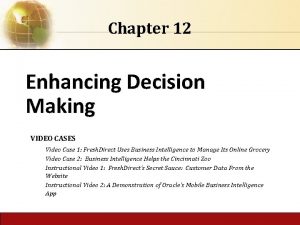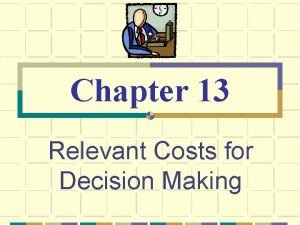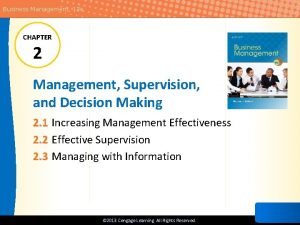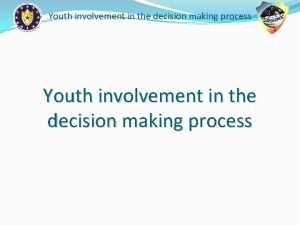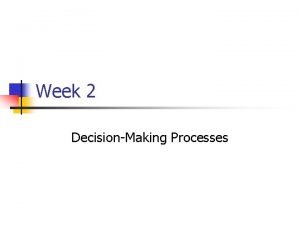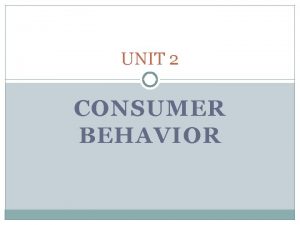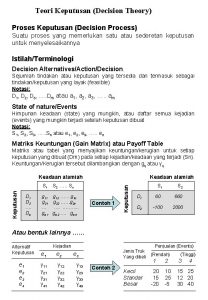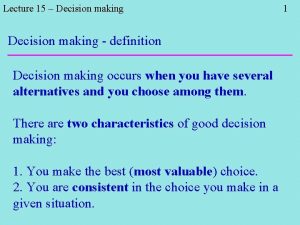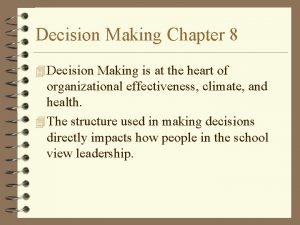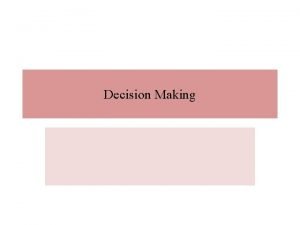Lecture 5 Enhancing Decision Making Chapter 12 Enhancing





































- Slides: 37

Lecture 5 Enhancing Decision Making Chapter 12 Enhancing Decision Making 12. 1

Management Information Systems LEARNING OBJECTIVES • Describe different types of decisions and the decisionmaking process. • Assess how information systems support the activities of managers and management decision making. • Demonstrate how decision-support systems (DSS) differ from MIS and how they provide value to the business. 12. 2

Management Information Systems LEARNING OBJECTIVES (cont’d) • Demonstrate how executive support systems (ESS) help senior managers make better decisions. • Evaluate the role of information systems in helping people working in a group make decisions more efficiently. 12. 3

Management Information Systems Procter & Gamble Restructures Its Supply Chain • Problem: Cost pressures, complex supply chain. • Solutions: Deploy modeling and optimization software to maximize return on investment and predict the most successful supply chain. • Modeling software fueled with data from Oracle data warehouse improved efficiency and reduced costs. • Demonstrates IT’s role in restructuring a supply chain. • Illustrates digital technology improving decision making through information systems. 12. 4

Management Information Systems Decision Making and Information Systems • Business value of improved decision making • Improving hundreds of thousands of “small” decisions adds up to large annual value for the business • Types of decisions: • Unstructured: Decision maker must provide judgment, evaluation, and insight to solve problem • Structured: Repetitive and routine; involve definite procedure for handling so they do not have to be treated each time as new • Semistructured: One part of problem has clear-cut answer provided by accepted procedure 12. 5

Management Information Systems Decision Making and Information Systems • Senior managers: • Make many unstructured decisions • E. g. Should we enter a new market? • Middle managers: • Make more structured decisions but these may include unstructured components • E. g. Why is Sales report showing decline in Rahimyarkhan? • Operational managers, rank and file employees • Make more structured decisions • E. g. Does customer meet criteria for credit? 12. 6

Management Information Systems Decision Making and Information Systems Information Requirements of Key Decision-Making Groups in a Firm Senior managers, middle managers, operational managers, and employees have different types of decisions and information requirements. Figure 12 -1 12. 7

Management Information Systems Decision Making and Information Systems • Four stages of decision making 1. Intelligence • Discovering, identifying, and understanding the problems occurring in the organization 2. Design • Identifying and exploring solutions to the problem 3. Choice • Choosing among solution alternatives 4. Implementation • 12. 8 Making chosen alternative work and continuing to monitor how well solution is working. How can we make it Better

Management Information Systems Decision Making and Information Systems Stages in Decision Making The decision-making process can be broken down into four stages. 12. 9 Figure 12 -2

Management Information Systems Decision Making and Information Systems • Information systems can only assist in some of the roles played by managers • Classical model of management • Five functions of managers • Planning, organizing, coordinating, deciding, and controlling • More contemporary behavioral models • Actual behavior of managers appears to be less systematic, more informal, less reflective, more reactive, and less well organized than in classical model • Mintzberg’s behavioral model of managers defines 10 managerial roles falling into 3 categories 12. 10

Management Information Systems Decision Making and Information Systems • Work at Great Pace More than 600 Activities per Day • Fragmented Activities • Current Specific and Adhoc Information • Prefer Oral form of Communication • Diverse and Complex Web of Contact 12. 11

Management Information Systems Decision Making and Information Systems • Managerial roles • Interpersonal roles: • Informational roles: • Decisional roles: Figurehead (Symbolic Duties, Emp Award) Leader (Support Subordinates) Liaison (Organizational Levels) Nerve center (Receive Up-to-date & Concrete Info) Disseminator Spokesperson Entrepreneur (Initiate New Activities) Disturbance handler Resource allocator (Needy Staff) Negotiator (Mediate B/w Conflicting Groups) 12. 12

Management Information Systems Decision Making and Information Systems • Three main reasons why investments in information technology do not always produce positive results 1. Information quality • High-quality decisions require high-quality information • Accuracy, Integrity, Consistency, Completeness, Validity, Timeline, Accessibility. 2. Management filters • Managers have selective attention and have variety of biases that reject information that does not conform to prior conceptions • CISCO- Cancelling the Order on Non-Availability 3. Organizational culture • 12. 13 Strong forces within organizations resist making decisions calling for major change – Blame game, Poor Economy

Management Information Systems for Decision Support • Four kinds of systems for decision support • Management information systems (MIS) • Decision support systems (DSS) • Executive support systems (ESS) • Group decision support systems (GDSS) 12. 14

Management Information Systems for Decision Support • Management information systems (MIS) • Help managers monitor and control business by providing information on firm’s performance and address structured problems • Typically produce fixed, regularly scheduled reports based on data from TPS • E. g. exception reports: Highlighting exceptional conditions, such as sales quotas below anticipated level • E. g. California Pizza Kitchen MIS • For each restaurant, compares amount of ingredients used per ordered menu item to predefined portion measurements and identifies restaurants with out-of-line portions 12. 15

Management Information Systems for Decision Support • Decision-support systems (DSS) • Support unstructured and semi structured decisions • Model-driven DSS • Earliest DSS were heavily model-driven • What if, Strong User Interface • E. g. Voyage-estimating DSS (Calculates Financial & Technical Data) • Data-driven DSS • Some contemporary DSS are data-driven • Use OLAP (Online Analytical Process) and data mining to analyze large pools of data • E. g. business intelligence applications • Email Videos of Resort Depending upon Data of Customer 12. 16

Management Information Systems for Decision Support • Components of DSS • Database used for query and analysis • Current or historical data from number of applications or groups • May be small database or large data warehouse • User interface • Often has Web interface • Software system with models, data mining, and other analytical tools 12. 17

Management Information Systems for Decision Support Overview of a Decision-Support System The main components of the DSS are the DSS database, the user interface, and the DSS software system. The DSS database may be a small database residing on a PC or a large data warehouse. Figure 12 -3 12. 18

Management Information Systems for Decision Support • Model: • Abstract representation that illustrates components or relationships of phenomenon; may be physical (Model plane), mathematical (Equation), or verbal (Sales Order) model • Statistical models (Product Sales to Different Ages) • Optimization models (Maximize or Minimize Variable, Cost, P&G) • Forecasting models (Historical Data to Project Future) • Sensitivity analysis models (What-If) sense of pattern • 12. 19 Impact on Price What if I Want to Increase Sale by one Million)

Management Information Systems for Decision Support • Using spreadsheet pivot tables to support decision making • Online Management Training Inc. (OMT Inc. ), sells online management training books and streaming online videos to corporations and individuals • Records of online transactions can be analyzed using Excel to help business decisions, e. g. : • Where do most customers come from? • Where average purchases higher? • What time of day do people buy? • What kinds of ads work best? 12. 20

Management Information Systems for Decision Support Sample List of Transactions for Online Management Training Inc. This list shows a portion of the order transactions for Online Management Training Inc. (OMT Inc. ) on October 28, 2006. Figure 12 -5 12. 21

Management Information Systems for Decision Support • Microsoft Excel spreadsheet software • Pivot table: • Categorizes and summarizes data very quickly • Displays two or more dimensions of data in a convenient format • Pivot. Table Wizard has three elements • Empty Pivot. Table: • With labels for rows, columns, and data areas • Pivot. Table Field List • Lists fields in list or database • Pivot. Table Toolbar 12. 22

Management Information Systems for Decision Support The Excel Pivot. Table Wizard Figure 12 -6 The Pivot. Table Wizard in Excel makes it easy to analyze lists and databases by simply dragging and dropping elements from the Field List 12. 23

Management Information Systems for Decision Support A Pivot Table that Determines Regional Distribution of Customers Figure 12 -7 By dragging and dropping fields to row and data areas of the pivot table form, you can quickly produce a table showing the relationship between region and number of customers. You will need to use the Field Settings button on the Toolbar to produce this table in order to redefine the Cust ID field as a count rather than a sum so Excel reports the number of customers, not the sum of their customer IDs, which would be meaningless. 12. 24

Management Information Systems for Decision Support A Pivot Table that Examines Two Dimensions Figure 12 -8 In this pivot table, we can examine where our customers come from in terms of two dimensions: region and advertising source. It appears nearly 40 percent of the customers respond to email campaigns, and there are some regional variations in this theme. 12. 25

Management Information Systems for Decision Support • Business value of DSS • Burlington Coat Factory: DSS for pricing • DSS manages pricing and inventory nationwide, considering complex interdependencies between initial prices, promotions, markdowns, cross-item pricing effects and item seasonality • Syngenta: DSS for profitability analysis • DSS determines if freight charges, employee sales commissions, currency shifts, and other costs in proposed sale make that sale or product unprofitable • Compass Bank: DSS for customer relationship management • DSS analyzes relationship between current and savings account activity and default risk to help it minimize default risk in credit card business 12. 26

Management Information Systems for Decision Support • Data visualization tools: • Help users see patterns and relationships in large amounts of data that would be difficult to discern if data were presented as traditional lists of text • Geographic information systems (GIS): • Category of DSS that use data visualization technology to analyze and display data in form of digitized maps • Used for decisions that require knowledge about geographic distribution of people or other resources, e. g. : • Helping local governments calculate emergency response times to natural disasters 12. 27

Management Information Systems for Decision Support • Web-based customer decision-support systems (CDSS): • Support decision-making process of existing or potential customer • Automobile companies that use CDSS to allow Web site visitors to configure desired car • Financial services companies with Web-based assetmanagement tools for customers. Risk Grades. com • CUBA 12. 28

Management Information Systems Executive Support Systems (ESS) • Executive support systems (ESS) • Integrate data from different functional systems for firm wide view • Incorporate external data, e. g. stock market news, competitor information, industry trends, legislative action • Unstructured and Semi Structured Decision Making • Include tools for modeling and analysis • Primarily for status, comparison information about performance 12. 29

Management Information Systems Executive Support Systems (ESS) • Business value of executive support systems • Enables executive to review more data in less time with greater clarity than paper-based systems • Result: Needed actions identified and carried out earlier • Improves management performance • Increases upper management’s span of control • Can enable decision making to be decentralized and take place at lower operating levels – Askari CNG Project • Increases executives’ ability to monitor activities of lower units reporting to them 12. 30

Management Information Systems Executive Support Systems (ESS) • National Life: ESS for business intelligence • National Life: Markets life insurance, health insurance, and retirement/investment products executive information system • Executive information system: • Allows senior managers to access corporate databases through Web interface • Shows premium dollars by salesperson • Authorized users can drill down into these data to see product, agent, and client for each sale • Data can be examined by region, by product, and by broker, and accessed for monthly, quarterly 12. 31

Management Information Systems Group Decision-Support Systems (GDSS) • What Is a GDSS? • Interactive, computer-based system used to facilitate solution of unstructured problems by set of decision makers working together as group • Designed to improve quality and effectiveness of decision-making meetings • Make meetings more productive by providing tools to facilitate: • Planning, generating, organizing, and evaluating ideas • Establishing priorities • Documenting meeting proceedings for others in firm 12. 32

Management Information Systems Group Decision-Support Systems (GDSS) • Components of GDSS • Hardware • Facility: Appropriate facility, furniture, layout • Electronic hardware: Audiovisual, computer, networking equipment • Software • Electronic questionnaires, electronic brainstorming tools, idea organizers • Tools for voting or setting priorities, stakeholder identification and analysis tools, policy formation tools, • Group dictionaries • People • Participants and trained facilitator, support staff 12. 33

Management Information Systems Group Decision-Support Systems (GDSS) • Overview of GDSS meeting • Each attendee has workstation, networked to facilitator’s workstation and meeting’s file server • Whiteboards on either side of projection screen • Seating arrangements typically semicircular, tiered • Facilitator controls use of tools during meeting • All input saved to server, kept confidential • After meeting, full record (raw material and final output) assembled and distributed 12. 34

Management Information Systems Group Decision-Support Systems (GDSS) Group System Tools Figure 12 -9 The sequence of activities and collaborative support tools used in an electronic meeting system facilitate communication among attendees and generate a full record of the meeting. Source: From Nunamaker et al. , “Electronic Meeting Systems to Support Group Work, ” Communications of the ACM, July 1991. Reprinted by permission. 12. 35

Management Information Systems Group Decision-Support Systems (GDSS) • Business value of GDSS • Supports greater numbers of attendees • Without GDSS, decision-making meeting process breaks down with more than 5 attendees • More collaborative atmosphere • Guarantees anonymity • Can increase number of ideas generated and quality of decisions made 12. 36

Management Information Systems Group Decision-Support Systems (GDSS) • Business value of GDSS (cont. ) • Most useful for idea generation, complex problems, large groups • Successful use of GDSS depends on many factors • Facilitator’s effectiveness, culture and environment, planning, composition of group, appropriateness of tools selected, etc. 12. 37
 Enhancing decision making
Enhancing decision making Enhancing decision making
Enhancing decision making No decision snap decision responsible decision
No decision snap decision responsible decision Slidetodoc.com
Slidetodoc.com Chapter 6 prices and decision making assessment answers
Chapter 6 prices and decision making assessment answers Five step decision making process
Five step decision making process Chapter 2 economic systems and decision making answer key
Chapter 2 economic systems and decision making answer key Management chapter 5 planning and decision making
Management chapter 5 planning and decision making Financial decision making process
Financial decision making process Chapter 2 economic systems and decision making
Chapter 2 economic systems and decision making Copyright
Copyright Relevant cost for decision making solution chapter 13
Relevant cost for decision making solution chapter 13 Chapter 2 economic systems and decision making answer key
Chapter 2 economic systems and decision making answer key Chapter 11 decision making and relevant information
Chapter 11 decision making and relevant information Chapter 2 management supervision and decision making
Chapter 2 management supervision and decision making Chapter 11 decision making and relevant information
Chapter 11 decision making and relevant information Options-based planning
Options-based planning Chapter 1 section 3 economic choices and decision making
Chapter 1 section 3 economic choices and decision making 01:640:244 lecture notes - lecture 15: plat, idah, farad
01:640:244 lecture notes - lecture 15: plat, idah, farad Bayesian decision theory lecture notes
Bayesian decision theory lecture notes Sargur srihari
Sargur srihari Decision tree and decision table examples
Decision tree and decision table examples Youth involvement
Youth involvement Nasw essential steps for ethical problem solving
Nasw essential steps for ethical problem solving Systematic decision making process
Systematic decision making process What doing our country
What doing our country Mamdm
Mamdm Using recursion in models and decision making sheet 3
Using recursion in models and decision making sheet 3 Defining moments
Defining moments Unit 4 lesson 1 decision making
Unit 4 lesson 1 decision making How to improve marketing performance
How to improve marketing performance Types of decision making
Types of decision making Pestec higher business
Pestec higher business Decision making unit example
Decision making unit example Decision categories
Decision categories Three roles of marketing research
Three roles of marketing research Critical decision making model
Critical decision making model Contoh soal pohon keputusan dan jawabannya
Contoh soal pohon keputusan dan jawabannya

